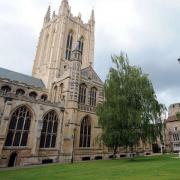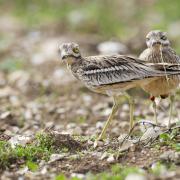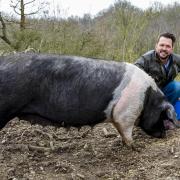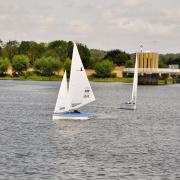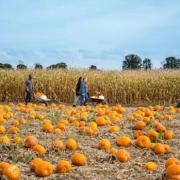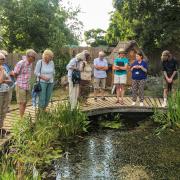The sun hangs in the sky in front of you, glinting on the ocean below as you soar towards land. A thousand miles behind you lies your summer breeding grounds, now slipping towards an icy Arctic winter. You still have far to go but hunger and fatigue are taking their toll and you’re in need of a place to safely rest and refuel if you hope to complete your journey.
Following the coastline, you spot what you’re looking for; wide expanses of mud, shallow water and tufted plant-life stretch below. Already anticipating your meal, you descend, joining thousands of other birds flocking to this vital margin between land and sea.
This is what I imagine it’s like to be a migratory bird on the East Atlantic Flyway, a wild bird superhighway in the sky, in autumn, passing through the UK on the way from your distant summer breeding grounds in Scandinavia or Siberia to your equally distant winter home in Southern Europe or Africa.
From a human perspective it’s sometimes hard to consider the scale of the journey that up to 17 million birds make each year, migrating to, from or through the UK on an epic intercontinental commute. Out of sight is out of mind, but it’s important to remember that many of the birds found on the coastal wetlands of East Anglia are just visiting.
England’s east coast wetlands, including those found in Suffolk, occupy a vital mid-point on the East Atlantic Flyway. In spring we start to welcome birds coming north to breed including Little Ringed Plover and Avocet, while in winter we provide a mild comfortable climate for species that like to breed high in the arctic such as Brent Geese or Green Sandpiper.
Alongside the numerous more sedentary visitors are the many passage species who appear only fleetingly in spring and autumn to rest and refuel before carrying on. These include Black-tailed Godwits, Whimbrel and Greenshank.

But you might ask why wetlands are that important for migrating birds at all, are they really worth protecting? The simple answer is that coastal wetlands are some of the hardest-working and most vulnerable habitats that we have.
Mudflats are made up of rich silty material that writhe with protein-packed worms, larvae and other invertebrates. Lagoons and creeks teem with fish and amphibians while reedbeds and saltmarsh provide excellent cover for roosting and breeding.
From the point of view of an Arctic Tern, riding in the fast lane of the East Atlantic Flyway on its annual migration to Antarctica, a coastal wetland is the perfect service station.

The east coast wetlands stretch from the Humber Estuary in Yorkshire to the River Thames in Kent. Occupying pride of place in the middle, the Suffolk coast plays a pivotal role connecting these coastal wetlands which form a vital chain of habitats. This connectivity is what makes this landscape so important and the reason why we need every chain link to stay intact.
The RSPB is proud to have a significant presence along the Suffolk coast and to contribute to the protection of its fragile wetlands. RSPB Dingle Marshes near Dunwich includes a large part of one of the largest freshwater reedbeds in the UK, while just to the south sits RSPB Minsmere, one of the jewels in the crown of RSPB’s wetland reserves.
This flagship site is a rich mosaic of varied wetland habitats and is host to a great diversity of species including Bittern and Avocet. In fact, it was at RSPB Minsmere in 1947 that the Avocet first returned to breed in the UK after going extinct more than half a century earlier.

Continuing down the coast we come to the lower part of the Alde-Ore Estuary, a unique and dynamic section of coastline where the RSPB manages a mosaic of wetland nature reserves. Perhaps most notable and oldest of these is Havergate Island; the only island in Suffolk and a flourishing haven for wildlife.
In particular, Havergate has recently become a home to a well-established population of breeding Spoonbills. This colony enjoys the isolation of the island and is the second largest in the UK and the only ground nesting Spoonbills colony here. Spoonbills are a rare UK breeding species with only a handful of breeding sites nationally.
Before the RSPB acquired Havergate Island it was used as summer grazing farmland, protected by poorly maintained sea defences and battered by storm surges. During the second world war the island was abandoned, and the tidal sluices failed. The grassland was flooded and inundated by saltwater. This transformed the grassland into an isolated wetland paradise for breeding waders and wintering wildfowl. Fast forward to today and this is how the RSPB manage the site, no longer attempting to keep out the sea but working with it.

The beauty of Havergate Island’s most recent incarnation is that it acts as a buffer, protecting nearby sea defences and coastal communities by allowing surge tides to flood into the lagoons. This is how coastal wetlands can benefit nature and society together.
With the Earth warming up due to climate change comes sea-level rise and increasingly severe storm surges. Across the east coast wetlands, the RSPB works with other environmental organisations, government bodies like the Environment Agency and local authorities to protect fragile coastal habitats and to create new areas where we can.
Increased space for nature means more space for migratory birds to breed, feed and rest. It also means improved resilience for the entire coastline and protection from flooding and erosion. Without its remarkable wetlands the Suffolk coast would be quite literally unrecognisable.

The value of our east coast wetlands in supporting migratory bird populations cannot be overstated, and the landscape has recently been nominated for UNESCO World Heritage Status.
Achievement of this globally recognised status would bring well deserved attention to the landscape and would mirror the success of the Waddensea, a UNESCO World Heritage Site stretching down the coast of Denmark, Germany and the Netherlands, which comprises the largest intertidal mudflat in the world and was designated for the same natural value inherent to England’s east coast wetlands.
Although the landscape has been tentatively accepted by UNESCO, the journey towards gaining World Heritage Status is not a short one and UNESCO keep the bar high to maintain the calibre and integrity of the title.

To demonstrate that the east coast wetlands deserve that title and that we can protect its natural value is going to require involvement from everyone living along the coastline including local authorities, county councils, environmental groups and coastal communities.
To find out more about our wetland nature reserves in Suffolk or to see how you can support the work of the RSPB visit bit.ly/RSPBSuffolk





